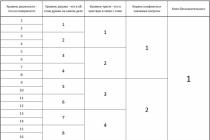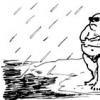Account 10 “Materials” is intended to account for the enterprise’s inventories (raw materials, fuel, spare parts, etc.).
The account is active, synthetic, and has several subaccounts. You can read about what types of accounts there are. In the context of an account, you can maintain analytical accounting by type of material and production assets.
TO account 10 “Materials” Sub-accounts can be opened:
- 10-1 “Raw materials and supplies”;
- 10-2 “Purchased semi-finished products and components, structures and parts”;
- 10-3 “Fuel”;
- 10-4 “Containers and packaging materials”;
- 10-5 “Spare parts”;
- 10-9 “Inventory and household supplies”;
- and others.
 The Debit of account 10 reflects any receipts of materials, and the Credit records their write-off (disposal).
The Debit of account 10 reflects any receipts of materials, and the Credit records their write-off (disposal).
The balance of account 10 “Materials” can only be debit, since the account is active!
I propose to consider the main standard transactions for account 10.
- Materials received from supplier D-10 K-60/76
- VAT is reflected on received materials D-10 K-60/76.
- Materials were received from the accountable person D-10 K-71.
- The materials contributed as a contribution to the authorized capital of D-10 K-75 have been capitalized.
- During the inventory, unaccounted materials were identified D-10 K-91
- Materials received as a result of the liquidation of fixed assets D-10 K-91 were capitalized
- Received materials donated by another organization D-10 K-98.
- Materials were written off for non-production needs (improving working conditions) - D-91 K-10.
- Materials from the production of D-10 K-20 have been returned.
- Materials for the construction of fixed assets D-08 K-10 were written off.
- Materials were written off for the main production of D-20 K-10.
- Materials were written off for auxiliary production D-23 K-10.
- The cost of materials is included in the cost of selling D-44 K-10.
- The cost of materials for victims of emergency situations (fire) was written off - D-99 K-10.
An enterprise has the right to write off materials for production using the following valuation methods:
- at the cost of each unit;
- (FIFO method);
- at the cost of the most recent purchases (LIFO method - not used since 2008).
The method must be selected and prescribed in the accounting policy.
Let’s solve a small problem to reinforce the topic:
A furniture production plant purchased 7 boards at a price of 100 rubles per m, excluding VAT. Charged for delivery of boards is 150 rubles, excluding VAT. The payment for materials and delivery was paid from the bank account. For the production of the cabinet, 3 boards were written off at the average cost.
Make postings.
Solution:
- Let's calculate VAT on boards = 700 * 0.18 = 126 rubles.
- Let's calculate VAT on transport costs = 150 * 0.18 = 27 rubles.
- Transport costs are evenly distributed among the boards.
- Let's calculate the amount of written-off boards using the average cost method: 850/7*3 = 364.29 rubles.
Let's make the wiring:
- Materials from the supplier D-10 K-60 were capitalized - 700 rubles.
- VAT is reflected on purchased materials D-19 K-60 - 126 rubles.
- Transport costs are reflected - D-10 K - 60 - 150 rubles.
- VAT is reflected on transport costs – D-19 K-60 – 27 rubles.
- Materials D-20 K-10 were written off for production - 364.29 rubles.
Balance sheet for account 10(hereinafter referred to as OSV) is necessary to ensure compliance with all requirements for analytics supported in the “Materials” account. Account 10 is one of the few that, according to the order of the Ministry of Finance from Russia 10.31.2000 No. 94n must be maintained by individual items and storage locations.
Description of account 10
This account is active. This means that the account balance can only be a debit balance, a credit balance is not allowed. The debit of the account reflects the receipt of materials, and the credit reflects the write-off (for example, for production, for sale).
All inventories with the same name and dimensional characteristics must have their own unique item number (code). This allows the material to be identically identified by different employees of the organization: supplier, storekeeper, accountant.
The organization must maintain records of materials at storage locations. This is due to the fact that the same material can be stored in different warehouses. As a rule, a storekeeper or other employee is responsible for the safety of materials in a warehouse, with whom a liability agreement must be concluded.
Important! The balance sheet for account 10, formed in the context of warehouses, shows the balances of material inventories for each materially responsible person.
Key points when forming SALT on a count of 10
2 methods of analytical accounting of materials are discussed in great detail in Chapter. VII section 2 Methodological guidelines for accounting of industrial production, approved by order of the Ministry of Finance of Russia dated December 28, 2001 No. 119n. This document lays out the foundations on which you need to rely when organizing materials accounting. At the same time, it is necessary to make modern adjustments to the development of software products for accounting.
The main thing that must be taken into account when forming OSV:
- SALT is a summary report that should indicate:
- opening balance in quantitative and monetary terms;
- income in quantitative and value terms;
- consumption in quantitative and monetary terms;
- ending balance in quantitative and monetary terms.
- The SALT is first generated for each warehouse, then all statements for warehouses are collected into a consolidated SALT for the organization as a whole. Then, based on the summary report, synthetic accounting data is obtained, which is reflected in the reporting.
- Despite automated accounting, warehouse cards for materials accounting must be required. The posting of receipts and disposals in them is carried out by the financially responsible person in quantitative terms. A card is created for each item number.
- Primary documents on the movement of materials must be on paper, and they must have “live” signatures.
Checking SALT and warehouse data
Work with primary documents on the movement of materials in organizations can be structured in 2 directions:
- The primary document (for example, a demand invoice) is written out manually at the time the material is received or issued, signed and handed over to the accountant. The accountant enters data into the program, making entries in the appropriate accounts. In this case, the material code, the warehouse through which the movement took place, and balance sheet accounts must be correctly indicated.
- First, postings are made in the program, i.e. the movement of material is reflected, and then the primary document is printed, which must be signed by the persons participating in the business transaction.
We will not dwell on the pros and cons of each of these methods of reflecting and generating primary documents. Often it all depends on the software used in the enterprise. It is important to understand that in both cases the influence of the human factor is great. Data may be entered into the program using the wrong item number or warehouse. And this will lead to incorrect formation of OSV.
If the financially responsible person timely posts documents on the movement of materials on warehouse accounting cards, then at the end of the month he must have the correct balance for each item calculated. And when the WWS arrives from the accounting department to the warehouse, the storekeeper must check it with the data on the cards.
Important! It is necessary to reconcile the data of the OCB and the cards. This procedure will allow timely identification of discrepancies, finding their causes and, if necessary, making changes to accounting or warehouse records.
Balance sheet for account 10
Let us consider, using an example, the main points associated with the formation of the SALT, in particular, how the procedure for receipt and write-off of materials occurs and how these movements are reflected in the SALT.
Example
NTK LLC received materials from the supplier in November 2018 (at the beginning of the month there were already some leftover materials in its warehouse). Some of the inventory was written off for production, and some was sold. Materials are assessed at average cost.
Admission. NTK LLC received from the supplier TORG-12, invoice and materials:
|
Name |
Quantity |
Unit price, without VAT |
Code assigned to the material |
|
White enamel |
|||
|
Primer |
|||
|
Varnish for external works |
|||
|
Water based varnish |
Write-off. Based on the invoice requirement for production needs, the following was used:
|
Name |
Quantity |
Average unit cost |
Code assigned to the material |
|
Yellow enamel |
Implementation. The buyer was issued TORG-12 and an invoice:
SALT for November 2018:
Explanations for the tables:
1 Remaining: 100 kg x 60 rub. + receipt: 50 kg x 90 rub. Average cost of 1 kg: (100 x 60 + 50 x 90) / 150 kg = 70 rub.
2 There was no arrival. The average cost is equal to 7,500 / 15 = 500 rubles.
3 There was no arrival. The unit cost is calculated based on the balance: 2,000 / 10 = 200 rubles.
4 Remaining: 20 kg x 206 rub. + receipt: 100 kg x 200 rub. Average cost of 1 kg: (20 x 206 + 100 x 200) / 120 = 201 rub.
5 There was no arrival. The average cost is calculated based on the balance: 3,000 / 60 = 50 rubles.
6 The average cost of 1 kg is calculated as follows: (balance at the beginning: 50 kg x 95.20 rubles + receipt: 30 kg x 100 rubles) / 80 = 97 rubles. Remaining at the end: 80 kg x 97 rub. = 7,760 rub.
In this example, we considered a situation where receipts and expenses were made within the same warehouse. If there are several storage locations, a similar OSV must be generated for each.
In addition to being valued at average cost, units of material can also be valued at cost per unit and using the first-in, first-out (FIFO) method. More details about the assessment of materials upon disposal can be found in PBU 5/01 “Accounting for Inventory and Inventory” (Section III).
Results
It is difficult to imagine a production organization that purchases a small amount of material assets. The process of forming OSV itself is simple. The main problem is the variety of items, warehouses, financially responsible persons and a large volume of primary documents.
Several participants may be involved in the chains of acquisition and write-off of materials: a supplier, a storekeeper, workers or craftsmen who receive materials for production, and sales employees. The primary document can get lost at any stage of inventory movement and not reach the accountant. So, first of all, the accountant is interested in creating a document flow that will allow receiving primary data in a timely manner and in full.
Currently, SALTs are generated automatically, based on primary documents entered into accounting programs. However, do not forget that you need to oblige the storekeeper (or other materially responsible person) to keep warehouse records in quantitative terms (in cards or special journals). Then, discrepancies identified during reconciliation of accounting and warehouse data will help you find documents that did not reach the accountant or storekeeper.
Any organization acquires materials for the company’s activities not for their own sake. And the purchased valuables will not lie dead weight in the warehouse for the director to admire. They are intended for use in production, sales or administrative purposes. Therefore, purchased materials are subsequently consumed in production. However, in the warehouse the storekeeper or warehouse manager is responsible for them, and the materials are taken into account on account 10. When the materials leave the warehouse, the situation will change: the account and the person in charge will change. In this article we will analyze the write-off of materials with step-by-step instructions for this procedure for you. Contents of the article: 1. Accounting entries for the write-off of materials 2. Registration of the write-off of materials 3. Write-off of materials - step-by-step instructions if not all are consumed 4. Standards for writing off materials for production 5. An example of a write-off act 6.
Accounting for account 10: postings, examples. receipt and write-off of materials
Attention
The organization sets its own standards for materials consumption (limits). They can be fixed in estimates, technological maps, etc.
similar internal documents.
Important
Documents of this kind are not developed by the accounting department, but by the unit that controls the technological process (technologists), and then they are approved by the manager. Materials are written off for production in accordance with approved standards.
You can write off materials in excess of the norm, but in each such case you need to explain the reason for the excess write-off. For example, correction of defects or technological losses.
The release of materials in excess of the limit is carried out only with the permission of the manager or his authorized persons. On the primary accounting document - the demand invoice, the act - there must be a note about the excess write-off and its reasons.
Account 10 materials in accounting: postings, examples, subaccounts
General rules for write-off Materials are the current assets of an organization. Materials are accounted for on account 10 “Materials”. In the process of life of the company, a large amount of low-value property is used.
After use, the material must be written off; leaving it on the balance sheet makes no sense, as this leads to an unreasonably inflated value of assets. The write-off deadlines are set individually by each organization; this information must be specified in the accounting policies.
This could be the month, quarter or day of disposal of the property. The disposal is documented by a write-off act. This document indicates the amount of materials written off and the total cost.
The form is developed by the company independently. For certain groups of materials, additional documents confirming consumption will be required.
Write-off of materials step-by-step instructions for accounting
Taking into account the received spare parts at the actual cost, the accountant of Gulliver LLC made the following entries: Debit Credit Description Amount Document 10 60 Components were received at the warehouse of Gulliver LLC (247,500 rubles - 37,754 rubles + 64,800 rubles - 9,885 rubles) 264,661 rubles . Consignment note 19 60 Reflects the amount of input VAT on received components (37,754 rubles + 9,885 rubles) 47,639 rubles. Consignment note 68 VAT 19 The amount of VAT sent for deduction is 47,639 rubles. Invoice 60 51 Funds were transferred in favor of Market JSC to pay for components and delivery (RUB 247,500.
+ 64,800 rub.) 312,300 rub.
Info
Payment order Uninvoiced delivery Avers LLC entered into an agreement with the Central meat processing plant for the supply of minced meat. In April 2015, a delivery was made for which the Central MK did not provide payment documents.
Account 10 in accounting
The director, as I understand it, is by default the financially responsible person. There is no separate order for it yet, but this is not a problem. I am worried about how I can justify the fact that I wrote off something and not something? Well, and VAT.
Shmymzik 17.10.2006, 17:24 The director, as I understand it, is by default the financially responsible person. Nothing of the kind. Justifications are needed FOR WRITTING OFF, and not for the lack of writing off. odri 17.10.2006, 17:25 Slightly confused. Is the justification for write-off the requirement-invoice M-11? Shmymzik 10.17.2006, 17:26 Of course you can. This is normal. Now, if you buy 300 pens and write them off at once, despite the fact that there are 2 employees, that would be suspicious, but otherwise everything is normal. 10/17/2006, 17:27
Excuse me, odri, but your question sounds like nonsense. The fact is that if I write off everything from account 10, I will get a loss, but the owner definitely needs a profit, albeit a small one.
The procedure for writing off materials in accounting (nuances)
To watch the video, click on it ⇓ You can get the slides for the presentation in the lesson using the link below. Download the presentation “Accounting for materials on account 10, postings and example” in PDF format Account 10 in accounting: receipt of materials Receipt of materials to the warehouse can be carried out both on the basis of primary documents received from the supplier, and without them (the so-called uninvoiced delivery ).
Let's look at each of these operations with an example. Delivery according to the settlement documents Gulliver LLC purchased materials from Market JSC - spare parts necessary for the production of products. The cost of components according to the delivery note was 247,500 rubles, VAT 37,754 rubles.
Delivery of components to the warehouse cost Gulliver LLC 64,800 rubles, VAT 9,885 rubles.
How to make a posting for materials write-off
For this purpose, 143 units of spare parts were transferred from the warehouse to the workshop at a price of 341 rubles per unit. The purposes for using materials were not indicated in the invoice request. The accountant of Revers LLC made the following entries in the accounting: Debit Credit Description Amount Document 10 Workshop No. 1 10 Main warehouse A batch of spare parts was transferred to workshop No. 1 from the main warehouse (143 units * 341 rub.) 48.763 rub. Request-invoice form M-11 20 10 Workshop No. 1 A batch of spare parts was written off as costs of RUB 48,763. Act of consumption of materials Operations for the disposal of materials may also be associated with technological losses incurred in excess of established standards or within their limits. Let's consider an example: the accounting policy of JSC Industrialist approved the threshold of technological losses at the level of 0.65% of the weight of materials used in production.
Methods for writing off materials for production 7. Option No. 1 - average cost 8. Option No. 2 - FIFO method 9. Option No. 3 - at the cost of each unit So, let's go in order. If you don't have time to read a long article, watch the short video below, from which you will learn all the most important things about the topic of the article. (if the video is not visible clearly, there is a gear at the bottom of the video, click it and select Quality 720p) We will look at write-offs of materials in more detail than in the video later in the article. 1. Accounting entries for writing off materials So, let's start by determining where purchased materials can be sent.
Consignment note for the current supply of materials 19 60 Reversal of the VAT amount on an uninvoiced supply RUB 22,454. Consignment note for the current supply of materials 20 10 Reversal of the cost of minced meat transferred for the production of sausages 124,746 rubles.
Consignment note for the current supply of materials 43 20 Reversal of the cost of sausage products at the market price (cost of purchased minced meat) 124,746 rubles. Consignment note for the current supply of materials 90.2 43 Reversal of the write-off of the actual cost of shipped products (sausages) at the price of minced meat (uninvoiced delivery) RUB 124,746. Bill of lading for the current supply of materials 10 60 The cost of minced meat is reflected according to the documents (163,400 rubles - 24,925 rubles) 138,475 rubles. Bill of lading for the current supply of materials 19 60 The amount of VAT on the supply of minced meat is reflected 24.925 rubles.
Do I need to write off all materials on account 10?
Example of a write-off act Therefore:
- - or you issue and immediately write off only what is actually consumed (in this case, the requirement of an invoice is quite sufficient)
- - or you draw up an act for writing off materials (transmitting a demand invoice, and then gradually writing off acts for writing off).
If you use write-off acts, do not forget to also approve their form as part of the accounting policy. The act usually indicates the name, and, if necessary, the item number, quantity, accounting price and amount for each item, number (code) and (or) name of the order (product, product) for the manufacture of which they were used, or number (code) and (or) the name of the costs, the quantity and amount according to consumption standards, the quantity and amount of consumption in excess of the standards and their reasons. An example of what such an act might look like is in the picture below.
Option No. 3 – at the cost of each unit At the cost of a unit of inventory, i.e. Each unit of materials has its own cost. This method is not applicable for ordinary cardboard boxes. Cardboard boxes are no different from each other. But materials and goods used by the organization in a special manner (jewelry, precious stones, etc.), or inventories that cannot normally replace each other, can be valued at the cost of each unit of such inventories. Those. If all our boxes were different, we would put a different tag on each one, then each of them would have its own cost. Here are the most important questions on the topic of writing off materials: step-by-step instructions are now before your eyes. For those who keep records in the 1C: Accounting program, watch a video tutorial on writing off materials in this program.
Such tracking of material consumption will allow you to achieve greater reliability in accounting and correctly calculate income tax. Please note that this applies not only to materials that go into production, but also to any property, including stationery used for administrative needs.
Materials should not be issued “in reserve”. They must be used immediately. Therefore, a one-time operation to write off 10 calculators for an accounting department of 2 people, during an audit, will certainly raise questions as to what purpose they were required in such quantities. 4.
Account 10 in accounting is necessary to collect data on the organization’s ownership of materials, as well as their movement. In this article we will talk about the features that need to be taken into account when using this account.
The concept of materials and their types
The rules for using account 10 “Materials” are regulated by the chart of accounts and instructions for it, approved by order of the Ministry of Finance of the Russian Federation dated October 31, 2000 No. 94n. Materials are a type of inventory that is intended for the manufacture of products or for the economic needs of an organization. The chart of accounts provides for 11 sub-accounts, formed by type of materials based on economic characteristics:
- Raw materials and materials that are the basis of manufactured goods and are necessary for the normal functioning of the enterprise.
- Purchased semi-finished products and components necessary for the production of products, for the use of which it is necessary to carry out additional work on them.
- Fuel used for heating, operating vehicles and other needs inherent in a production organization.
- Containers and packaging materials used for the production of containers.
- Spare parts that are necessary for the repair of fixed assets.
- Other materials generated as a result of defects, production waste, write-off of fixed assets, etc.
- Materials outsourced for processing, the cost of which is transferred to the cost of manufactured goods.
- Construction materials necessary for the developer's work.
- Inventory and household supplies that are working capital and used as means of labor.
- Special equipment and protective clothing in the warehouse.
- Special equipment and clothing in use.
Information on the use of each subaccount is available in the instructions for the chart of accounts. An organization can open other sub-accounts necessary for its specific needs. Receipt of materials is shown by the entry
Write-off of materials
When used, materials are written off as expenses by recording
Dt 20, 21, 23, 25, 26, 29, 44 Kt 10.
When materials are disposed of as a result of sale, donation, or write-off, they are included in other expenses:
Dt 91.2 Kt 10.
Results
Account 10 accumulates data on the organization's current assets. It depends on the specifics of the production which sub-accounts are appropriate to open for it. On account 10, accounting can be carried out both at actual and at accounting prices. In the second case, accounts 15 and 16 will also apply.
Brief description of account 10
Information on the acquisition, availability and disposal of working capital, designated by the abbreviation MPZ or the word “materials”, is reflected in the synthetic account 10 of the same name. The procedure for accounting for materials is established by PBU 5/01 (Order of the Ministry of Finance dated 06/09/2001 No. 44n) and the Guidelines for accounting of MPZ (Order of the Ministry of Finance dated December 28, 2001 No. 119n).
The shelf life of the materials is less than one year.
Account 10 Materials is active, it records the company's property. The account balance is debit. The debit reflects the receipt of materials based on primary documents from the supplier, the credit reflects the write-off of inventories, disposal is recorded with internal primary expenditure documents. Document flow is carried out using standardized forms or on your own forms if they contain generally mandatory details.
There are two ways to determine the cost of inventories - based on the actual cost of acquisition (clause 62 of the Guidelines) or the accounting price (clause 80). For accounting using the first method, account 10 is used. When accounting for inventories at the accounting price, additional accounts 15 and 16 are used, but this is the topic of another article.
The write-off of materials is carried out in one of the ways (clause 16 of PBU 5/01): at the average cost, at the cost of each individual unit, or using the FIFO method.
The choice of subaccounts of account 10, accounting methods, methods of inclusion in cost groups and control over the movement of materials, as well as document flow are fixed in the accounting policy.
Analytical accounting on account 10 is carried out by item names, batches, warehouses, and divisions.
In accordance with PBU 5/01, the debit balance of account 10 is reflected in line 1210 “Inventories” in section II “Current assets” of the balance sheet.
NOTE! Accounting for materials that do not belong to the company is kept on off-balance sheet accounts (002 and 003). Materials purchased for resale on an ongoing basis are considered goods and are accounted for in account 41.
Subaccounts to account 10
Inventory recorded on account 10 includes material assets in the form of inventories, which are intended for the manufacture of products or the economic needs of the company (raw materials, semi-finished products, fuel, spare parts, building materials, equipment, tools, etc.), paragraph 42 Methodical instructions.
The Chart of Accounts (Order of the Ministry of Finance dated October 31, 2000 No. 94n) and the Instructions for its application propose the following subaccounts of account 10 in accounting.
|
Name of the type of MPZ with explanations |
|
|
Raw materials and materials (the basis for the manufacture of products, goods or products) - for production, processing, economic needs |
|
|
Purchased semi-finished products and components - for completing and manufacturing products. NOTE! Semi-finished products of own production - an integral part of the work in progress - are NOT taken into account on account 10 |
|
|
Fuel (petroleum products, solid and gaseous) - for heating, transport operation, energy generation and other economic needs |
|
|
Containers and parts used to assemble containers. NOTE! Trading companies account for empty containers and under goods in account 41 |
|
|
Spare parts - for repair and replacement of worn-out parts of fixed assets. NOTE! Tires (on wheels and spare parts) for the vehicle are taken into account in the initial cost of the vehicle on account 01 |
|
|
Other materials - defects, production waste, worn-out parts of equipment, etc. |
|
|
Outsourced materials |
|
|
Building materials (for developers) - for construction, repair and installation work |
|
|
Inventory, tools and household supplies - means of labor |
|
|
Special equipment and clothing in warehouse |
|
|
Special equipment and clothing in use |
Opening all sub-accounts is not necessary. The organization itself determines which subaccounts are needed to maintain inventory accounting. For specific activities, you can open other subaccounts.
Typical transactions for account 10
The correspondence in the accounting of account 10 with other accounts depends on the source of receipt or direction of disposal of inventories.
Basic postings for account 10 (without using accounts 15 and 16):
- Receipt of inventories from the supplier.
- Other methods of receiving materials.
- Disposal of materials.
NOTE! With simplified accounting, costs for the purchase and delivery of materials can be included in expenses for ordinary activities as they occur.
Don't know your rights?














